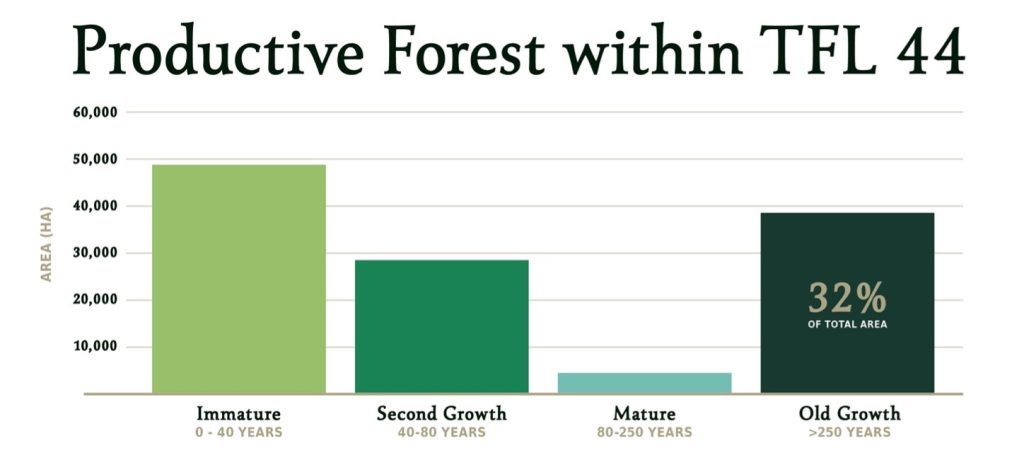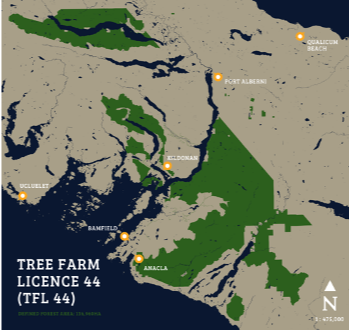
Industry News
News
Forestry Management
Harvesting
Nearly 1/3 of the forests in Tree Farm Licence 44 are old-growth: study
April 7, 2022 By C̕awak ʔqin Forestry
 There are 38,672 ha of old growth forests in TFL 44, representing 32 per cent of the total area of productive forest. Image provided by C̕awak ʔqin Forestry.
There are 38,672 ha of old growth forests in TFL 44, representing 32 per cent of the total area of productive forest. Image provided by C̕awak ʔqin Forestry.
A comprehensive technical analysis shows 32 per cent of the forests in Tree Farm Licence 44 (TFL 44) on Vancouver Island are old-growth (older than 250 years) with this number expected to increase over the next seven generations to reach 39 per cent.
The analysis was completed at the request of C̕awak ʔqin Forestry (formerly named TFL 44 Limited Partnership) to support decision making for the recently announced Integrated Resource Management Plan (IRMP) – a ground-breaking Indigenous-led approach to resource planning coordinated by C̕awak ʔqin Forestry that is expected to take two years to complete. The report also supports efforts by C̕awak ʔqin Forestry to be climate positive by 2030.
The study found that three-quarters of the old-growth in TFL 44 is protected or outside of the timber harvesting land base. The report further concludes that 29 per cent of the more productive sites contain old-growth, versus claims of 1 to 3 per cent across B.C., as noted in other studies.
“This report provides C̕awak ʔqin Forestry with a baseline status of old-growth in TFL 44 from which the IRMP can work,” said Joel Mortyn, a registered professional forester (RPF) and forest inventory expert who authored the report. “From a conservation focus, the data tells us that old forests are less represented in the highest productivity stands and the drier ecosystems in TFL 44, and the current Indigenous-led planning process will be important in addressing those areas. It is also clear that old-growth is not at risk of disappearing from TFL 44 and will, in fact, be higher than current levels in the future due to the established network of protected areas.”
The study was peer reviewed by experts in the field of forestry, ecology, and timber supply analysis.
“One of the biggest problems with the debate about the extent of old-growth in British Columbia is the lack of reliable data. In TFL 44, modern techniques such as LiDAR are being used to create a more accurate picture of what is there,” said Dr. John Innes, former dean of the faculty of forestry and current professor and Forest Renewal BC (FRBC) chair of forest management at the University of British Columbia. “This data, combined with Indigenous knowledge, will provide a solid, knowledge-based foundation for conservation decisions.”
“The study sets a standard in terms of how to assess old-growth for a given management unit or traditional territory,” said Andres Enrich, MF, RPF, department co-chair and professor of the forestry department in the faculty of science and technology at Vancouver Island University. “Forest management in B.C. is shifting towards a more holistic and ecological approach with processes such as modernized land use planning, Timber Supply Review and First Nations Integrated Resource Management Plans requiring old-growth assessments to help guide decisions.”
The study will also support discussions at the upcoming Anacla Old-Growth Summit on April 28, 2022, hosted by Huu-ay-aht First Nations and co-chaired by C̕awak ʔqin Forestry and Huu-ay-aht Forestry Limited Partnership. The summit will bring together 50 coastal Indigenous nations to share information on their stewardship and resource management planning and decision-making processes.
“Facts matter and so do millennia of on-the-ground knowledge passed down through our ancestors,” said Robert J. Dennis Sr., Chief Councillor, Huu-ay-aht First Nations. “This study confirms what we have always known – that there is more old-growth than claimed and that even under existing forest stewardship regimes, the amount of old-growth will grow over our Indigenous seven-generation planning horizon.
“It’s time to move past the battle of numbers and continue planning for a future where we continue to have old-growth in perpetuity, as well as strong resilient communities where everyone and everything benefits.”
Dennis added that these planning efforts will be supported by the Indigenous Witwak Guardians who are responsible for protecting, monitoring, and enhancing C̕awak ʔqin Forestry operations.
“The report shows the state of our forests after a century of excluding our people from the lands we have lived on and from since time immemorial,” said Tayii Ḥaw̓ił ƛiišin (Derek Peters), Head Hereditary Chief, Huu-ay-aht First Nations. “Now the world is turning to our Nations to lead the journey to an even better way where, through Indigenous leadership grounded in respect, we ensure a brighter future for everyone and everything.”
Key findings from the Technical Summary of old growth forests in TFL 44 (April 2022) report:

Map of Tree Farm Licence 44 (TFL 44)
- Close to one third (32%) of all forests in TFL 44 are old growth. This is projected to increase to 39% over the next 250 years in the absence of natural disturbances.
- Over three-quarters (76%) of old growth in TFL 44 is either formally protected or outside of the timber harvesting land base.
- Protected areas in TFL 44 capture proportionally more of the tallest old growth. As stand height increases from <10 m to >45 m tall, protected old growth increases from 4% to 62%.
- There is considerably more medium to high productivity old growth than has been recently claimed:
- 25% of stands with a site index >25 m in TFL 44 are old growth as opposed to claims of 1%.
- 29% of stands with a site index >20 m in TFL 44 are old growth as opposed to claims of 3% provincially.
- Old growth is not as well represented in the highest productivity sites (9% old growth in stands with site index >30 m) as it is in the lowest productivity sites (45% old growth in stands with a site index <15 m).
- Old growth in stands with site index >30 m is forecast to increase from 9% to 30% over the next 250 years.
- All biogeoclimatic ecosystem classification (BEC) variants in TFL 44 have >10% old growth, the threshold used by the Old Growth Technical Advisory Panel to define remnant forest.
- At a coastal scale, the CWHxm2 BEC variant has 9% old growth.
The study reflects the input of and review by respected resource stewardship experts and academia in the fields of forestry, ecology, biology, statistics, and timber supply analysis, including:
- Bryce Bancroft, RPBio, RPF (Hon), Director, Symmetree Consulting Group Ltd.
- Allen Banner MSc, RPF (Ret.), RPBio – Forest Ecologist
- Bruce Blackwell, MSc, RPBio, RPF, B.A. Blackwell and Associates Ltd.
- Cam Brown, RPF, Manager, Resource Management and Technology Group, Forsite Consultants
- Andres Enrich, MF, RPF, Department Co-Chair and Professor, Forestry Department, Faculty of Science and Technology, Vancouver Island University
- Dr. Kim Iles, PhD, Forest Biometrician and Forest Inventory Specialist
- Dr. John Innes, PhD, Professor and FRBC Chair of Forest Management, Faculty of Forestry, University of British Columbia
- Dr. Dominik Roeser, PhD, Associate Professor, Department of Forest Resources Management, Faculty of Forestry, University of British Columbia
Print this page